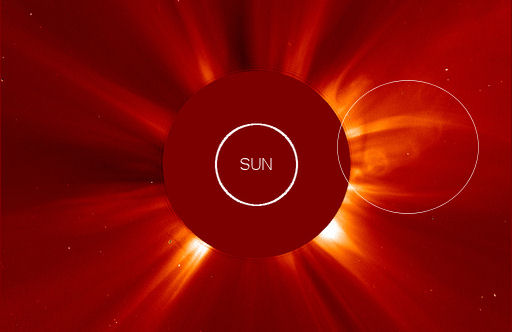EARTHSONG: A NASA spacecraft has recorded audio-frequency radio emissions coming from Earth. Some say the signals sound like whales; others liken them to the chirping of prairie dogs. What do you think? [audio] [video] [full story]
PLASMA PUFFS TARGET VENUS: Sunspot 1583 is in a near-constant state of eruption. Magnetic instabilities in the sunspot's magnetic canopy are hurling massive "puffs" of magnetized plasma into space. The Solar and Heliospheric Observatory caught some of them emerging during the early hours of Oct. 2nd; click to set the scene in motion:
Because AR1583 is on the farside of the sun, Earth is not in the line of fire. Venus, on the other hand, could receive a glancing blow from these clouds. Because Venus has no global magnetic field to protect it from solar storms, the impacts could erode small amounts of gas directly from the top of the planet’s atmosphere. Moreover, incoming plasma clouds can cause explosions in Venus's upper atmosphere called "hot flow anomalies." The space weather forecast for the second planet is stormy.

![]()
Solar wind
speed: 339.5 km/sec
density: 2.0 protons/cm3
explanation | more data
Updated: Today at 1447 UT
![]()
X-ray Solar Flares
6-hr max: C1 1332 UT Oct02
24-hr: C1 1332 UT Oct02
explanation | more data
Updated: Today at: 1359 UT
![]()
![]()
![]()
Daily Sun: 01 Oct 12
![]()
![]()
Departing sunspot 1583 poses a threat for M-class solar flares, not Earth-directed. Credit: SDO/HMI
![]()
![]()
![]()
Sunspot number: 59
What is the sunspot number?
Updated 01 Oct 2012
Spotless Days
Current Stretch: 0 days
2012 total: 0 days (0%)
2011 total: 2 days (<1%)
2010 total: 51 days (14%)
2009 total: 260 days (71%)
Since 2004: 821 days
Typical Solar Min: 486 days
Update 01 Oct 2012
The Radio Sun
10.7 cm flux: 136sfu
explanation | more data
Updated 01 Oct 2012
![]()
![]()
![]()
Current Auroral Oval:
![]()
Switch to: Europe, USA, New Zealand, Antarctica
Credit: NOAA/POES
![]()
![]()
![]()
Planetary K-index
Now: Kp= 2 quiet
24-hr max: Kp= 2 quiet
explanation | more data
![]()
Interplanetary Mag. Field
Btotal: 4.7 nT
Bz: 3.5 nT south
explanation | more data
Updated: Today at 1446 UT
![]()
![]()
![]()
Coronal Holes: 01 Oct 12
![]()
![]()
There are no large coronal holes on the Earth side of the sun. Credit: SDO/AIA.





